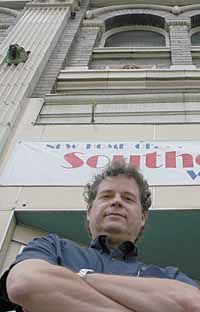| One of the buildings Kim Hyatt has come up with a plan for is the Southeast Paint building. It is actually an old theater that has been remodeled. |
For most people, downtown Price is what it is; a series of business buildings with different store fronts and facades. But if historical architect Kim Hyatt’s vision of what some of the buildings in that area could look like comes true, it will be like turning back time.
Hyatt, who was hired with a Utah State Historic Preservation grant by Price City to look at what could be done with historical buildings in town, says that as many as 10 of the downtown structures could be restored to close to original fronts that would make the various kinds of facades that exist now go away.
“One of the best things for building owners is that if the changes are consistent with historical images the remodels could meet standards for some state and federal tax credits,” says Price Community Director Nick Tatton. “There might also be some incentives through local funds like the RDA too.”
Hyatt, who was in town on Thursday to show officials and some building official what he had come up with after some study of various structures, said he has always had a passion for old buildings and believes if they can be saved and preserved they can be an attractive addition to a city.
While Helper has it’s historic district, Price has not had that. Many of Helpers Main Street buildings look like they have since most of them were built in the 1920’s and 1930’s. Many of Price’s downtown structures are older according to Hyatt; turn of the century to about 1920. Yet most have been drastically remodeled with either fake facades or parts replaced by glass tiles and metal coverings. Hyatt took a look at the buildings he could get old photos of and began to draw up some sketches of what he thought they could look like once again if the remodels were reversed.
“There are some buildings where things that have been done that are only cosmetic and could easily be reversed,” he said. “In other cases some of the remodels have taken away original features and restoral processes may have to work around those.”
The 10 buildings that Hyatt looked at in his report that was presented to a group of city officials and business owners include Breinholt Music, the Crown Theater, Olivetos Furniture, Southeast Paint (which was once the Star Theater, the Silvagni Building, the
Newhouse Hotel, Castle Valley Mall, Hard Hat Furniture and Fitness World.
Hyatt told the group that to follow a comprehensive approach to restoring and maintaining historic buildings, as well as to qualify for historic tax credits that any building owner would need to be sure they followed the United States Secretary of the Interiors standards for the treatment of historic properties.
Hyatt also explained that the problem with old buildings is that often when a structure begins to age, owners will spend money on cosmetic structural alterations, often ones that are not “sympathetic” to the original architectural designs.
“Some of what is done is of course based on the amount of money an owner has,” he told the group. “Some of these buildings probably suffered poor maintenance during the depression when people didn’t have much money. Others had remodels that were out of character with their original design. It looks like at one time a salesman came through and did a good job of selling a number of people on glass tiles, and so a number of these buildings have those. ”
To do his study Hyatt had to poke around in some of the buildings, and also asked local officials to try and find photos of what buildings looked like before the remodels.
“Underneath that metal exterior on the Silvagni Building (on the southeast corner of the Carbon Avenue and Main intersection) I could see some of what is there,” says Hyatt.
According to Hyatt’s report that building (which is really two buildings) would require the most expense to get it back to a more original form. The large aluminum louver system would be fairly easy to remove, but some of the porcelain tiles that were installed on the first level may have damaged original surfaces. He could not find a good original photo of the building which makes it a little harder to know what it looked like before the remodels.
On the 10 buildings, his cost estimates ranged from a little over $19,000 to over $160,000 for another.
“Of course these are just estimates, and certainly building owners would have to decide if it were worth it to them to do such restorations,” stated Hyatt.
The report included a section on each building, with photos, suggestions on what could be done and a drawing of changes that could be made.
Hyatt has been doing architectural work on historic buildings for almost 20 years, and has worked on various buildings across the state. His approach is a keep it simple one.
“It’s like the signs people want to put on buildings,” he says. “Being in business they want their building to show up, but the simplest of signs, such as a well painted sign on metal attached to the buildings is very attractive and adds to the character of the structure.”
Owners of buildings can now look at Hyatt’s recommendations and at least see what their buildings could look like. Copies of the report at available from the Price City offices.

